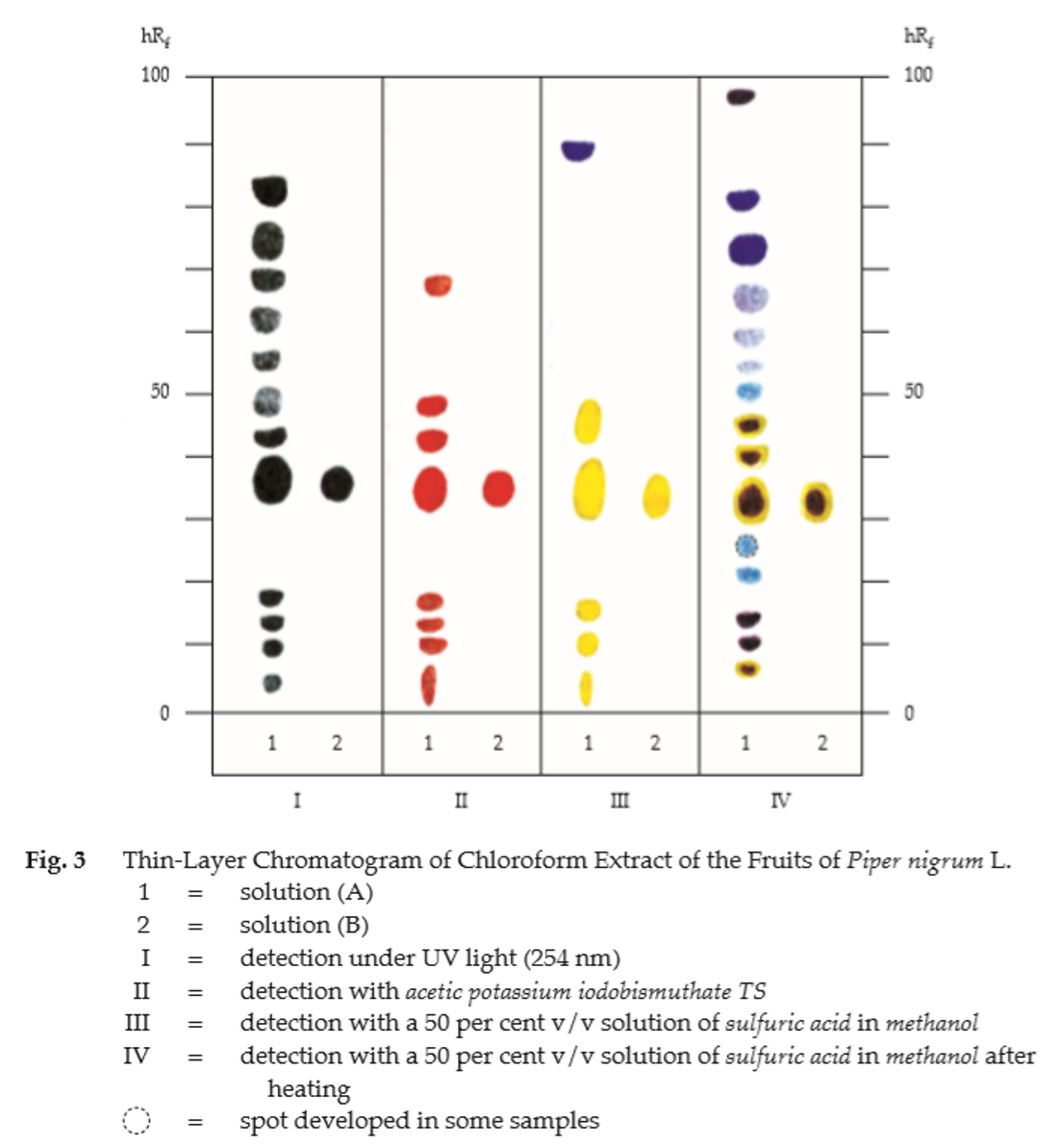ตำรามาตรฐานยาสมุนไพรไทย
Thai Herbal Pharmacopoeia
สำนักยาและวัตถุเสพติด กรมวิทยาศาสตร์การแพทย์ กระทรวงสาธารณสุข
Bureau of Drug and Narcotic, Department of Medical Sciences, Ministry of Public Health(Tinospora crispa (L.) Hook.f. & Thomson)
(Nelumbo nucifera Gaertn.)
(Centella asiatica (L.) Urb.)
(Centella Dry Extract)
(Centella Cream)
(Mesua ferrea L.)
(Piper sarmentosum Roxb.)
(Piper sarmentosum Roxb.)
(Pterocarpus santalinus L. f.)
(Santalum album L.)
(Senna tora (L.) Roxb.)
(Senna alata (L.) Roxb.)
(Senna Alata Tea)
(Piper retrofractum Vahl)
(Myristica fragrans Houtt)
(Andrographis paniculata (Burm. f.) Nees)
(Andrographis Capsules)
(Allium ascalonicum L.)
(Ocimum tenuiflorum L.)
(Curcuma longa L.)
(Turmeric Capsules)
(Turmeric Dry Extract)
(Turmeric Dry Extract Capsules)
(Arcangelisia flava (L.) Merr.)
(Curcuma sp.)
Harrisonia perforata (Blanco) Merr.
(Aristolochia pierrei Lecomte)
(Zingiber officinale Roscoe)
(Ginger Capsules)
(Ginger Tea)
(Cassia fistula L.)
(Nardostachys jatamansi (D. Don) DC.)
(Angelica sinensis (Oliv.) Diels)
Artemisia annua L.
(Ligusticum sinense Oliv. cv. Chuanxiong)
(Neopicrorhiza scrophulariiflora Pennell)
(Atractylodes lancea (Thunb.) DC.)
(Aucklandia lappa Decne)
(Terminalia chebula Retz.)
(Angelica dahurica (Hoffm.) Benth. & Hook. f. ex Franch. & Sav. var. dahurica)
(Kaempferia parviflora Wall. ex Baker)
(Hibiscus sabdariffa L.)
(Roselle Tea)
(Allium sativum L.)
(Zingiber zerumbet (L.) Sm.)
(Wurfbainia testacea (Ridl.) Škorničk.& A. D. Poulsen)
(Cannabis sativa L.)
(Myristica fragrans Houtt)
(Dracaena cochinchinensis (Lour.) S. C. Chen)
(Ficus racemosa L.)
(Hyptis suaveolens (L.) Poit.)
Clerodendrum indicum (L.) Kuntze
(Phyllanthus emblica L.)
(Citrus hystrix DC.)
(Citrus hystrix DC.)
(Areca catechu L.)
(Momordica charantia L.)
Moringa oleifera Lam.
(Aegle marmelos (L.) Corrêa)
(Solanum trilobatum L.)
(Morus alba L.)
Gynostemma pentaphyllum(Thunb.)
Makino
(Clinacanthus nutans (Burm. f.) Lindau)
(Cissus quadrangularis L.)
(Mimusops elengi L.)
(Zingiber montanum (J. König) Link. ex A. Dietr.)
(Piper betle L.)
(Capsicum annuum L.)
(Capsicum Oleoresin)
(Capsicum Gel)
(Piper nigrum L.)
(Piper nigrum L.)
(Eurycoma longifolia Jack)
(Thunbergia laurifolia Lindl.)
(Piper wallichii (Miq.) Hand.-Mazz.)
Senna garrettiana (Craib) H. S. Irwin & Barneby
(Terminalia bellirica (Gaertn.) Roxb.)
(Terminalia chebula Retz.)
(Caesalpinia bonduc (L.) H. Roxb.)
(Tarlmounia elliptica (DC.) H. Rob., S. C. Keeley, Skvaria & R. Chan)
(Hog Creeper Vine Dry Extract Capsiles)
(Hog Creeper Vine Dry Extract)
(Brachypterum scandens (Roxb.) Miq.)
(Lepidium sativum L.)
(Nigella sativa L.)
(Cuminum cyminum L.)
(Foeniculum vulgare Mill.)
(Plantago ovata Forssk.)
(Pimpinella anisum L.)
(Carum carvi L.)
(Anethum graveolens L.)
(Trachyspermum ammi (L.) Sprague)
Albizia procera (Roxb.) Benth.
(Acorus calamus L.)
(Tiliacora triandra (Colebr.) Diels)
Cyanthillium cinereum (L.) H. Rob.
(Orthosiphon aristatus (Blume) Miq.)
Murdannia loriformis (Hassk.) R. S. Rao & Kammathy
(Capparis micracantha DC.)
(Chrysopogon zizanioides (L.) Roberty)
(Cyperus rotundus L.)
(Cannabis sativa L.)
(Syzygium aromaticum (L.) Merr. & L. M. Perry)
(Boesenbergia rotunda (L.) Mansf.)
(Acanthus ebracteatus Vahl)
(Acanthus ilicifolius L.)
(Kaempferia galanga L.)
(Curcuma comosa Roxb.)
Betula alnoides Buch.-Ham. ex D. Don
Cannabis sativa L.
Carthamus tinctorius L
Mitragyna speciosa (Korth.) Havil
Mallotus repandus (Rottler) Müll. Arg
Azadirachta indica A. Juss. var. siamensis Valeton
Azadirachta indica A. Juss. var. siamensis Valeton
Punica granatum L.
Rhinacanthus nasutus (L.) Kurz
Baliospermum solanifolium (Burm.) Suresh
Curcuma aeruginosa Roxb
Boesenbergia kingii Mood & L. M. Prince
Senegalia rugata (Lam.) Britton & Rose
Acacia concinna (Willd.) DC.
Senegalia rugata (Lam.) Britton & Rose
Acacia concinna (Willd.) DC.
Senna alexandriana Mill. var. alexandriana
Cassia acutifolia Delile, Cassia angustifolia Vahl
Butea superba Roxb. ex Willd.
[Plaso superba (Roxb. ex Willd.) Kuntze, Rudolphia superba (Roxb. ex Willd.) Poir.
Pueraria candollei Graham
ex Benth. var. mirifica (Airy Shaw & Suvat.) Niyomdham
Streblus asper Lour.
Suregada multiflora (A. Juss.) Baill. (Gelonium
multiflorum A. Juss.
Black Pepper is the dried green mature fruit of Piper nigrum L. (Family Piperaceae), Herbarium Specimen Number: DMSC 667, Crude Drug Number: DMSc 0275.
Constituents Black Pepper contains volatile oil, alkaloids, of which piperine and piperettine, are its major components.
Description of the plant (Figs. 1a, 1b) Woody perennial climber, aromatic; branches stout, trailing and rooting at the nodes. Leaves simple, very variable in length, 12.5 to 17.5 cm long, 5 to 12.5 cm wide, sometimes glaucous beneath, apex acuminate, base acute, rounded or cordate, equal or unequal, basal nerves 5 to 9 with one pair running to apex; petiole 1.2 to 3.7 cm long, stout. Flower usually dioecious, but often the female bears 2 anthers, and the male a pistillode, anther 2-celled. Fruiting spike, 10 to 12 cm or more long. Fruit drupe, globose or ovoid, sessile, 1-seeded, 4 to 6 mm in diameter, orange-red to reddish when ripe. Seed usually globose; testa thin.
Description Odour, aromatic; taste, pungent.
Macroscopical (Fig. 1a) Subspherical, greyish brown to brownish black, superior, 3.5 to 6 mm in diameter; surface deeply and coarsely reticulately-wrinkled; remains of a sessile stigma visible at the apex; vertical section of the fruit shows a thin, narrow, dark pericarp, within which is the whitish kernel of the single seed, to which the pericarp firmly adheres; kernel consisting of almost entirely of perisperm, hollow at the centre, and, at its apex, surrounding a scanty endosperm in which the minute embryo is embedded.
Microscopical (Figs. 2a, 2b) Transverse section of the fruit shows epicarp, mesocarp, endocarp, spermoderm, and perisperm. Epicarp composed of a layer of epidermal cells containing small rectangular crystals about 6 to 10 μm long and 2 to 3 layers of thickened stone cells with rather large lumina intermingled with thin-walled parenchyma cells. Mesocarp composed of several layers of polygonal parenchyma cells, some of which are oil cells which occur more in the inner part; vascular bundles located in the middle part of mesocarp. Endocarp, a layer of light brown, lignified beaker cells. Spermoderm composed of 2 to 3 layers of compressed elongated cells, the innermost layer composed of larger cells containing dark brown contents. Perisperm composed of cells containing numerous angular starch grains up to 5 μm in diameter, some of which containing oil globules, resin and monoclinic crystals.
Black Pepper in powder possesses the diagnostic microscopical characters of the unground drug.
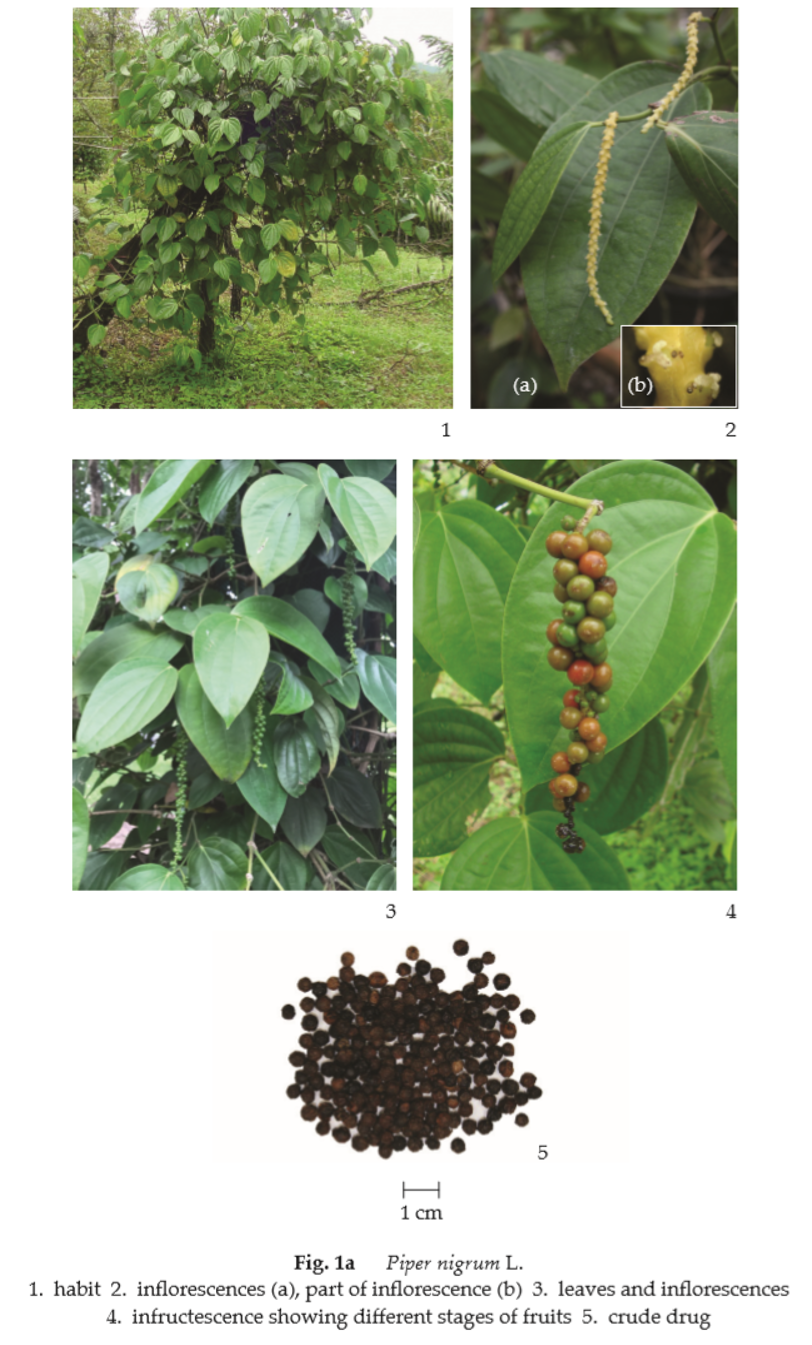
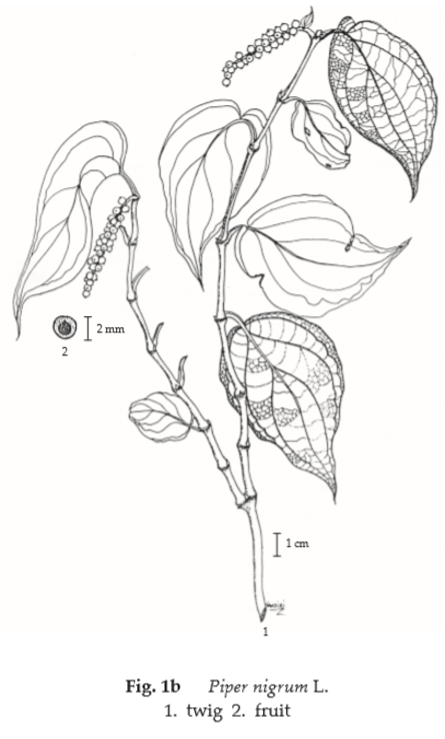
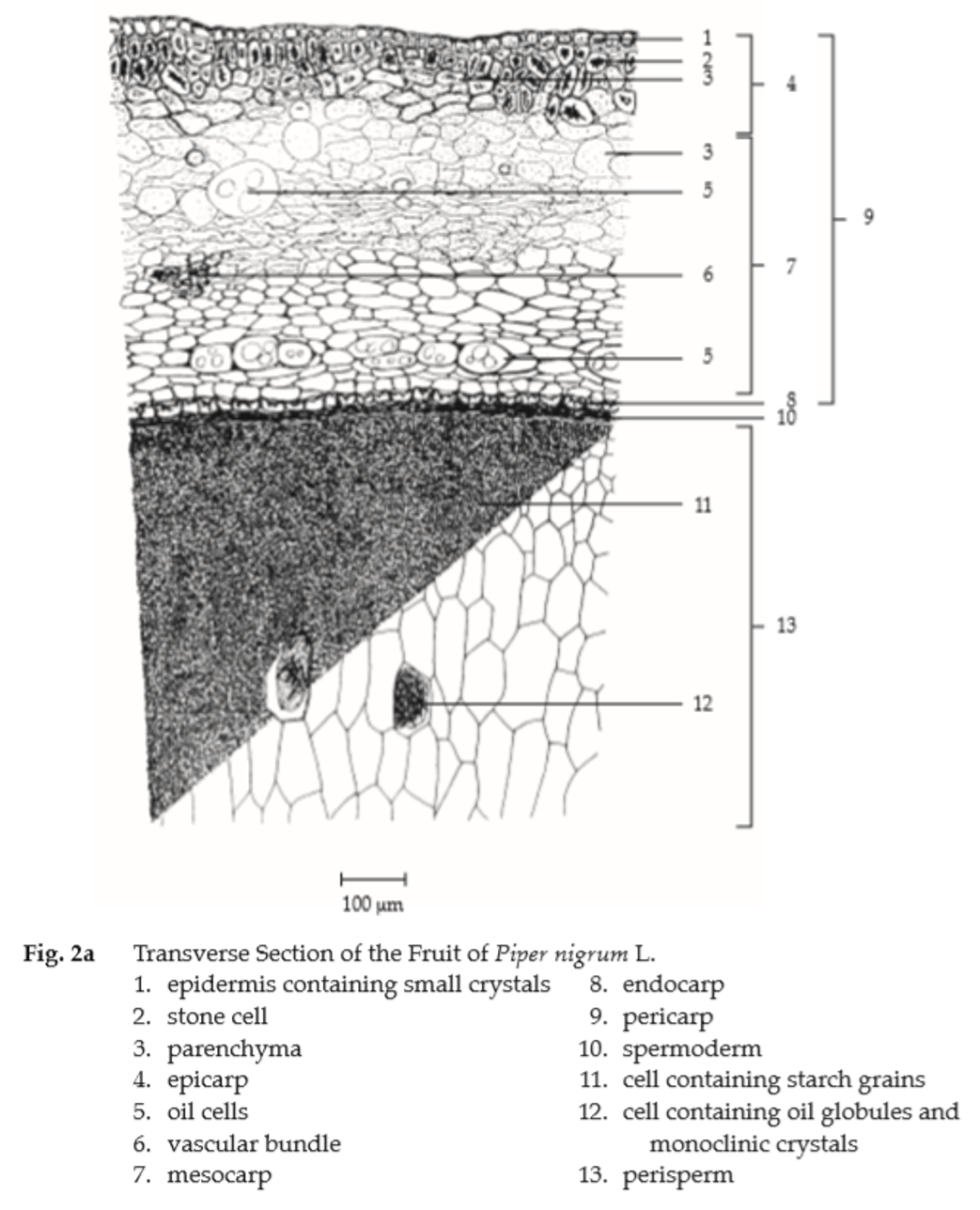
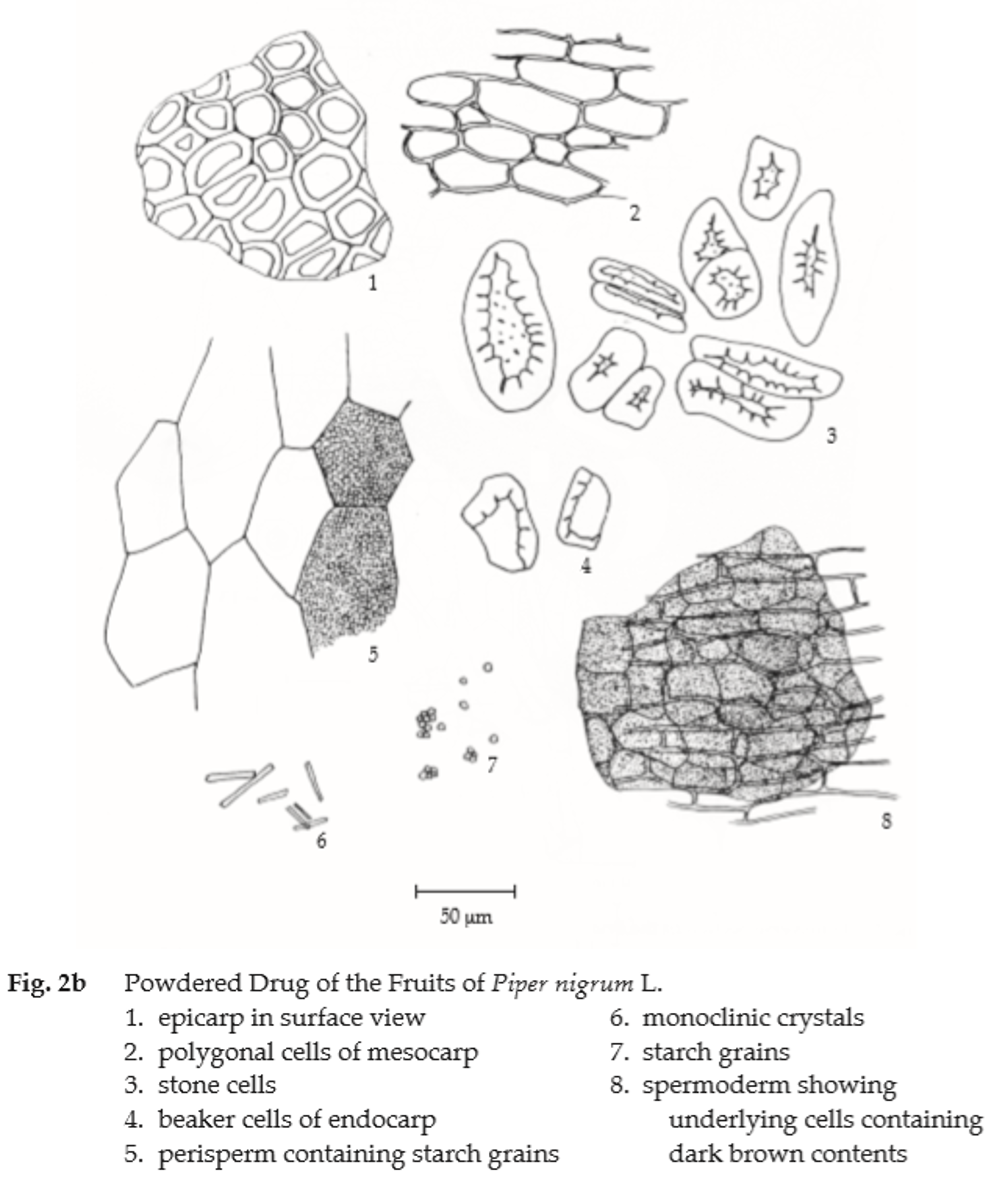
Packaging and storage Black Pepper shall be kept in well-closed containers, preferably of metal or glass, protected from light and stored in a cool and dry place.
Identification
A. Reflux 1 g of the sample, in No. 150 powder, with 20 mL of chloroform in a water-bath for 15 minutes, and filter (solution 1). Evaporate 2 mL of solution 1 to dryness. Dissolve the residue with 1 mL of ethanol, and add 0.5 mL of sulfuric acid: a brownish red colour is produced, and after set aside the colour changes to brown.
B. Evaporate 5 mL of solution 1 to dryness. Dissolve the residue with 0.5 mL of a 10 per cent v/v solution of sulfuric acid, and add a few drops of modified Dragendorff TS2: an orange precipitate is produced
C. Carry out the test as described in the “Thin-Layer Chromatography” (Appendix 3.1), using silica gel GF254 as the coating substance and a mixture of 60 volumes of hexane and 40 volumes of ethyl acetate as the mobile phase and allowing the solvent front to ascend 12 cm above the line of application. Apply separately to the plate, 5 μL each of the following two solutions. Prepare solution (A) by macerating 500 mg of the sample, in No.150 powder, in a 5-mL volumetric flask with chloroform for 10 minutes, and shaking frequently. Filter and evaporate the filtrate to dryness. Dissolve the residue in 1 mL of chloroform. For solution (B) dissolve 1 mg of piperine in 1 mL of chloroform. After removal of the plate, allow it to dry in air and examine under ultraviolet light (254 nm), marking the quenching spots. The chromatogram obtained with solution (A) shows a quenching spot (hRf value 28 to 38), corresponding to the piperine spot from solution (B), and several spots of higher and lower hRf values. Spray the plate with acetic potassium iodobismuthate TS; the spot due to piperine is dark orange (Table 1); see also Fig. 3.
Repeat the same procedure on another plate but spray with a 10 per cent v/v solution of sulfuric acid in methanol; the spot due to piperine is yellow. After spraying, allow the plate to dry in air for 15 minutes and heat at 110° until colours are fully developed. The chromatogram obtained with solution (A) shows a brownish yellow spot (hRf value 28 to 38) corresponding to the piperine spot from solution (B), and several other spots of different colours situated above and below that due to piperine (Table 1); see also Fig. 3.
Table 1 hRf Values of Components in Chloroform Extract of the Fruits of Piper nigrum L.
| Spot | hRf Value | Detection | |||
| UV 254 | Acetic Potassium Iodobismuthate TS |
10 Per Cent V/V Solution of Sulfuric Acid in Methanol |
|||
| before heating | after heating | ||||
| 1 2 3 4 5 6 7* 8 9 10 11 12 13 14 15 16 17 |
1-7 8-12 10-15 15-19 21-23 25-28 28-38 39-46 47-50 49-51 53-57 59-63 64-68 71-76 78-83 85-90 96-99 |
quenching quenching quenching quenching - - quenching quenching quenching - quenching quenching quenching quenching quenching - - |
pale orange orange orange orange - - dark orange orange orange - - - pale orange - - - - |
yellow yellow - yellow - - yellow - yellow - - - - - - pale violet - |
- yellow, centre brown pale purple pale purple blue blue yellow, centre brown yellow, centre brown yellow, centre brown blue bluish violet bluish violet bluish violet pale violet pale violet - pale purple |
*piperine
Water Not more than 14.0 per cent v/w (Azeotropic Distillation Method, Appendix 4.12).
Foreign matter Not more than 2.0 per cent w/w (Appendix 7.2).
Acid-insoluble ash Not more than 1.5 per cent w/w (Appendix 7.6).
Total ash Not more than 7.0 per cent w/w (Appendix 7.7).
Volatile oil Not less than 1.0 per cent v/w (Appendix 7.3H). Use 50 g, in No. 150 powder, freshly prepared and accurately weighed. Use 250 mL of water as the distillation liquid and a 500-mL round-bottomed flask. Distil at a rate of 2 to 3 mL per minute for 5 hours. Use 2.0 mL of xylene in the graduated tube.
Alkaloid content Not less than 5.0 per cent w/w of alkaloids, calculated as piperine, when determined by the following method.
Standard piperine solution Transfer about 20 mg of piperine, accurately weighed, into a 100-mL volumetric flask, add chloroform to dissolve and dilute to volume.
Standard piperine curve Transfer into five 25-mL volumetric flasks 0.2 mL, 0.4 mL, 0.6 mL, 0.8 ml, and 1.0 mL, respectively, of Standard piperine solution and add chloroform to make 1.0 mL. To each flask add 10.0 mL of chromotropic acid TS, shake vigorously and place in a water-bath for 30 minutes. Set aside for a few minutes, stopper, and allow to cool. Then add 10 mL of dilute sulfuric acid, mix well, allow to cool, and dilute with sufficient dilute sulfuric acid to volume. Measure the absorbances of the piperine-containing solutions relative to the blank at 570 nm (Appendix 2.2). Plot the readings and draw the curve of best fit.
Procedure Place 500 mg of Black Pepper, in No. 150 powder and accurately weighed, in an extraction thimble and insert the thimble into a soxhlet extractor of appropriate size.Moisten with 0.5 mL of chloroform, mix, allow to stand for about 5 minutes, make alkaline with 0.5 mL of ammonia TS, and mix. Macerate for 6 to 12 hours or overnight, cover with a pledget of absorbent cotton, add a sufficient quantity of chloroform, and extract until complete extraction of the alkaloids is effected (Appendix 7.4). Transfer the total mass to a 250-mL volumetric flask, dilute with chloroform to volume and filter. Transfer 1.0 mL of the filtrate to a 25-mL volumetric flask, and proceed as directed under Standard piperine curve, beginning with “Add 10.0 mL of chromotropic acid TS, ...”. Read the absorbance of the resulting solution, and by reference to the Standard piperine curve, calculate the content of alkaloids as piperine in the sample.
Dose 250 to 500 mg three times a day after meals.
